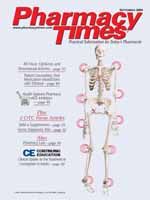Publication
Article
Pharmacy Times
ACEIs: A Brief Review of Their Pharmacotherapeutic Uses
Author(s):
Angiotensin-converting enzyme inhibitors (ACEIs) have been available since the early 1980s, approved initially for hypertension.1,2 Their roles in clinical practice have continued to expand, with ongoing research being conducted in numerous therapeutic areas. ACEIs have clinical utility and FDA approval for use in hypertension and congestive heart failure, and increasing evidence and ongoing research support their use in coronary artery disease (CAD) as well. Ten agents are now available (Table). Although some differences exist in pharmacokinetic parameters, clinical trials suggest a class effect.3-5
The mechanism of action of ACEIs is described in the Figure. ACEIs block the conversion of angiotensin I to angiotensin II, a potent endogenous vasoconstrictor. This results in inhibition of angiotensin II at both vascular and renal sites and may attenuate the release of catecholamines. The effect of this blockage includes reduced aldosterone secretion, decreased peripheral vascular resistance, and decreased preload and afterload. The resultant clinical benefits include reductions in blood pressure and improvements in cardiac output.
Other beneficial effects of ACEIs include reduction in glomerular pressure in the kidneys, supporting their role in diabetic neuropathy, in addition to inhibitor effects on the remodeling process in post?myocardial infarction patients. In addition to their effects on angiotensin II, ACEIs inhibit the degradation of bradykinin, a potent naturally occurring vasodilator. The benefits of this inhibition may include additional vasodilator benefits in both hypertension and heart failure.
Other alternative mechanisms also may be involved and may include the ability to reduce atherosclerotic progression and acute coronary events associated with arteriosclerosis. ACEI effects on arteriosclerosis may be mediated through their effects on plasminogen activator, vascular inflammation, and endothelial dysfunction.5-7
The adverse effects of ACEIs include hypotension, acute renal failure, cough, hyperkalemia, rash, and angioedema. The risk for hypotension is increased in patients with hyponatremia or in patients who have had recent increases in diuretic doses. Elderly patients and patients with low blood pressure should be started on low doses and titrated carefully.
Patients with renal impairment should be evaluated prior to the use of ACEIs, and lower doses are necessary. The mechanism of acute renal impairment is the loss of normal vasoconstrictor influences on the efferent arterioles from angiotensin II blockage, resulting in a reduction in hydrostatic pressure in the nephron. Acute renal failure may develop, especially if a patient is dependent on angiotensin-mediated efferent arteriolar vasoconstriction to maintain glomerular pressure.
Patients at risk for the development of acute renal failure include those with preexisting renal impairment, severe heart failure, hyponatremia, current use of nonsteroidal anti-inflammatory drugs, and dehydration. Although ACEIs are not contraindicated in patients with various degrees of renal impairment, cautious use is advised, with careful titration and monitoring. Because ACEIs retain potassium, hyperkalemia may develop.
Cough is another potential side effect and may develop early or late in therapy. Cough associated with ACEIs must be differentiated from cough from other causes, including cough related to heart failure or respiratory disease. If cough is identified as being associated with an ACEI and if it becomes intolerable to the patient, substitution with an angiotensin receptor blocker may be warranted.
Angioneurotic edema is a rare but serious complication of ACEI therapy and may include swelling of the tongue, lips, or larynx. Supportive care usually is necessary, and rechallenging with ACEIs is not recommended.
Contraindications to the use of ACEIs include pregnancy, bilateral renal artery stenosis, serum creatinine >3.0 mg/dL, history of angioneurotic edema, serum potassium >5.5 mEq/L, and systolic blood pressure <80 mm Hg (requires cautious use).
Drug interactions include those with potassium-sparing diuretics, potassium supplements, nonsteroidal anti-inflammatory agents, and agents that may synergistically lower blood pressure.
Monitoring parameters should include measurement of blood pressure, renal function, and serum potassium at intervals ranging from weekly to monthly, in addition to when signs are present of the adverse effects noted above.3
Pharmacotherapeutic Utility of ACEIs
Hypertension
ACEIs play a valuable role in the treatment of hypertension, and the JNC-VI guidelines8 support their role as firstor second-line agents. ACEIs are especially good choices for patients with concurrent comorbidities, including those with diabetes and heart failure. Doses usually are started low, especially in elderly patients, and titrated to response. ACEIs are excellent alone but also are effective and synergistic in combination with other antihypertensives, including diuretics and calcium channel blockers.1,2,9,10
Heart Failure
Numerous clinical trials support the role of ACEIs in the treatment of heart failure because of their ability to reduce morbidity and mortality in patients with mild-to-severe disease. ACEIs should be initiated in heart failure patients who can tolerate these agents, especially those with low ejection fractions (systolic dysfunction). ACEIs can be used concurrently with other heart failure medications, including diuretics, beta-blockers, and in some cases digoxin and aldosterone antagonists. ACEIs benefit heart failure patients by reducing preload and afterload, alleviating symptoms, improving clinical status/functional class, and slowing the progression of the disease.
With the concurrent use of diuretics and beta-blockers, dose adjustments may need to be made to maintain adequate blood pressure.11-14 The role of ACEIs in diastolic dysfunction (often defined as referring to patients with ejection fractions >40%), is not well understood and continues to be explored.15
Coronary Artery Disease
Clinical trials support the role of ACEIs in post?myocardial infarction patients due to their ability to impact the remodeling process and reduce morbidity and mortality.16 Recent data support their role, in high-risk cardiovascular patients (described as >55 years of age; with histories of cardiovascular disease, diabetes, smoking, hyperlipidemia, and hypertension; and without a diagnosis of heart failure).17 The mechanisms proposed in CAD patients may be related to their ability to improve surrogates of cardiovascular disease, including vascular compliance, endothelial-derived nitric oxide production, vascular relaxation, and plasma markers of inflammation, oxidative stress, and thrombosis. The use of ACEIs in high-risk CAD patients?including those with hypertension, diabetes, or heart failure?extends the use of this class of agents to a broad population of patients.16-20
Diabetes
Patients with diabetes may develop numerous complications, including microvascular and macrovascular complications. The use of ACEIs in diabetic patients reduces the risk and progression of both microvascular (nephropathy, retinopathy, neuropathy) and macrovascular complications (described as cardiovascular and cerebrovascular events). Clinical trials have demonstrated that the use of ACEIs in diabetic patients can prevent and/or slow the progression of these complications.7,9,21,22
Using nephropathy as an example, ACEIs reduce glomerular hydrostatic pressure, resulting in a reduction in protein loss (microalbuminuria), a marker used to measure the progression of renal disease.7 Other potential mechanisms may include improvements in insulin sensitivity and glucose metabolism.21 ACEIs should be utilized in all diabetic patients, especially those with comorbidities, including hypertension, heart failure, and CAD. Recent studies indicate that ACE inhibitors may reduce the development of type 2 diabetes in patients with essential hypertension, a population with a high prevalence of insulin resistance.21,22
Other Potential Roles That Are Being Investigated
Utility in a variety of other areas has been reported through observational studies and continues to be evaluated in small clinical trials. Future uses may include peripheral artery disease, stroke, migraine headaches, and dementia.22-25
Dr. DeMaagd is an associate professor of pharmacy practice at Ferris State University; a clinical pharmacist for the Geriatric Assessment Clinic/Bronson Methodist Hospital; a clinical instructor for Michigan State University Internal Medicine/Family Medicine Residency Programs; and an adjunct faculty member at Western Michigan University College of Allied Health.
For a list of references, send a stamped, self-addressed envelope to: References Department, Attn. A. Stahl, Pharmacy Times, 241 Forsgate Drive, Jamesburg, NJ 08831; or send an e-mail request to: astahl@mwc.com.










